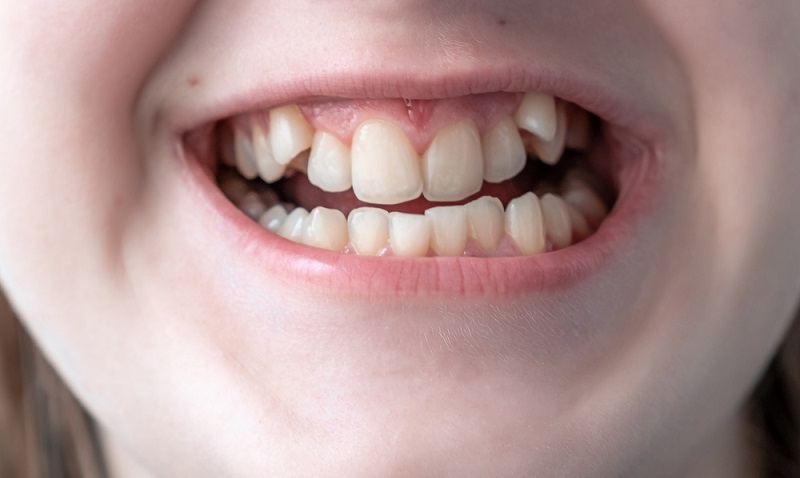Contents

Occlusion refers to the way the upper and lower teeth align and fit together when you bite. Ideally, there should be a slight overlap between the upper and lower teeth, with the grooves of the lower molars fitting into the points of the upper molars. This arrangement helps protect the tongue, cheeks, and lips from accidental biting.
Malocclusion, or improper alignment of the teeth and jaws, often runs in families, indicating a genetic component. It can result from mismatched jaw sizes, either between the upper and lower jaws or between the jaw and the teeth, leading to crowding or improper biting patterns. Other causes include jaw shape or congenital conditions like cleft lip and palate.
What is Class 2 Malocclusion?
Class 2 malocclusion, often known as "overbite" or "retrognathism," is a problem with the alignment of the teeth where the upper teeth significantly overlap the lower teeth while the jaws are closed.
If left untreated, this illness, which can affect both children and adults, may result in several dental and oral health issues.
What are the Causes of Malocclusion?
Malocclusion, which encompasses birth abnormalities like cleft lip and palate, is primarily hereditary in nature.
However, other elements, such as thumb sucking or prolonged dummy use, may also be at play.
These bad habits from childhood can cause teeth to move. But tooth position can also be affected by jaw trauma.
Other Causes
Childhood vices such as thumb sucking, tongue thrusting, dummy use past the age of three, and prolonged bottle use
Extra teeth, missing teeth, impacted teeth, or teeth with unusual shapes
Dental fillings, crowns, appliances, retainers, or braces that don't fit properly
Jaw fractures that are misaligned after a serious injury
The mouth and jaw tumours.
1. Genetics:
Class 2 malocclusions, among others, can be significantly influenced by hereditary factors.
2. Thumb Sucking:
Using a pacifier or thumb-sucking for an extended period throughout early childhood might change how the teeth and jaw are positioned.
3. Missing or Crowded Teeth:
Malocclusions can be caused by irregularities in the size and placement of teeth.
4. Dental Injuries:
A facial or jaw injury may cause a class 2 malocclusion by upsetting the teeth's and jaws' normal alignment.
What are the Types of Class 2 Malocclusion?
There are two main categories of class 2 malocclusion:
Division 1:
An obvious overbite results from the upper front teeth of this kind being greatly protruded. Frequently, the lower teeth point backwards.
Division 2:
The upper central incisors in Division 2 malocclusion are more upright, yet there is a profound overbite. Compared to Division 1, this type is less typical.
How to Fix Class 2 Malocclusion?
Class 2 malocclusion, also known as an overbite, occurs when the upper teeth protrude over the lower teeth. This condition can significantly affect your bite and may require early orthodontic treatment.
Here's a simplified overview:
Treatment Options:
Early Intervention:
Starting treatment early (ages 7-11) can prevent severe malocclusion. This often involves two phases: initial treatment during mixed dentition and a second round in early adolescence.Traditional Braces or Aligners:
These help align the teeth over time. Early treatment can shorten the duration and complexity of later treatment.Functional Appliances:
Devices like Twin Blocks can correct overjets (protruding upper teeth). They are more cost-effective and easier to manage compared to other appliances.
Benefits of Early Treatment:
Helps normalize jaw development.
Reduces the risk of dental injuries.
May boost a child's self-esteem.
Can prevent the need for tooth extractions.
Considerations:
Early treatment doesn't always change the underlying bone structure but can improve appearance.
The choice of treatment should consider the child's risk of trauma and need for improved self-esteem.
Orthodontic intervention is often used to treat class 2 malocclusions.
Here are some typical medical options:
1. Traditional Braces
Traditional braces are frequently employed to progressively reposition teeth into their ideal positions. Both children and adults who receive this treatment can benefit from it.
2. Functional Appliances
Functional appliances are used in developing children to promote healthy jaw development and alignment. Examples include Herbst appliances and headgear.
3. Dental Surgery:
To adjust the jaws in extreme cases of class 2 malocclusion, surgery may be required. Usually, this is taken into account for adult patients.
4. Retainers:
Following orthodontic treatment, retainers are frequently worn to preserve the teeth's repaired alignment and avoid recurrence.
5. Early Intervention:
Class 2 malocclusion in children may benefit from early orthodontic evaluation and treatment before it worsens.
Class 2 Malocclusion Surgery cost
The finest functional and aesthetically pleasing outcomes from these surgeries are achieved by skilled oral and maxillofacial surgeons who have worked with a variety of jaw abnormalities.
The patient's quality of life is significantly improved through jaw repair. Jaw reconstruction can be done using a variety of surgical procedures. These include using distraction osteogenesis, reconstructive plates, and transplants.
Grafts might be made of synthetic materials or ones taken from the patients themselves. Distraction osteogenesis helps lengthen short jawbone by utilizing the idea of new bone formation.
In India, the price of a jaw operation can range from 50,000 to 3,000,000 INR, depending on how complicated the procedure is.
Outlook
When teeth alignment issues are rectified early on, they are simpler, quicker, and less expensive to cure.
Children and teenagers respond best to treatment because their bones are still pliable and their teeth can be repositioned more easily.
Six months to two years or longer may pass throughout treatment. Depending on how much adjustment is required, the time will vary.
Adult orthodontic issues can be successfully treated, but it may take longer to utilize braces or other orthodontic appliances.


